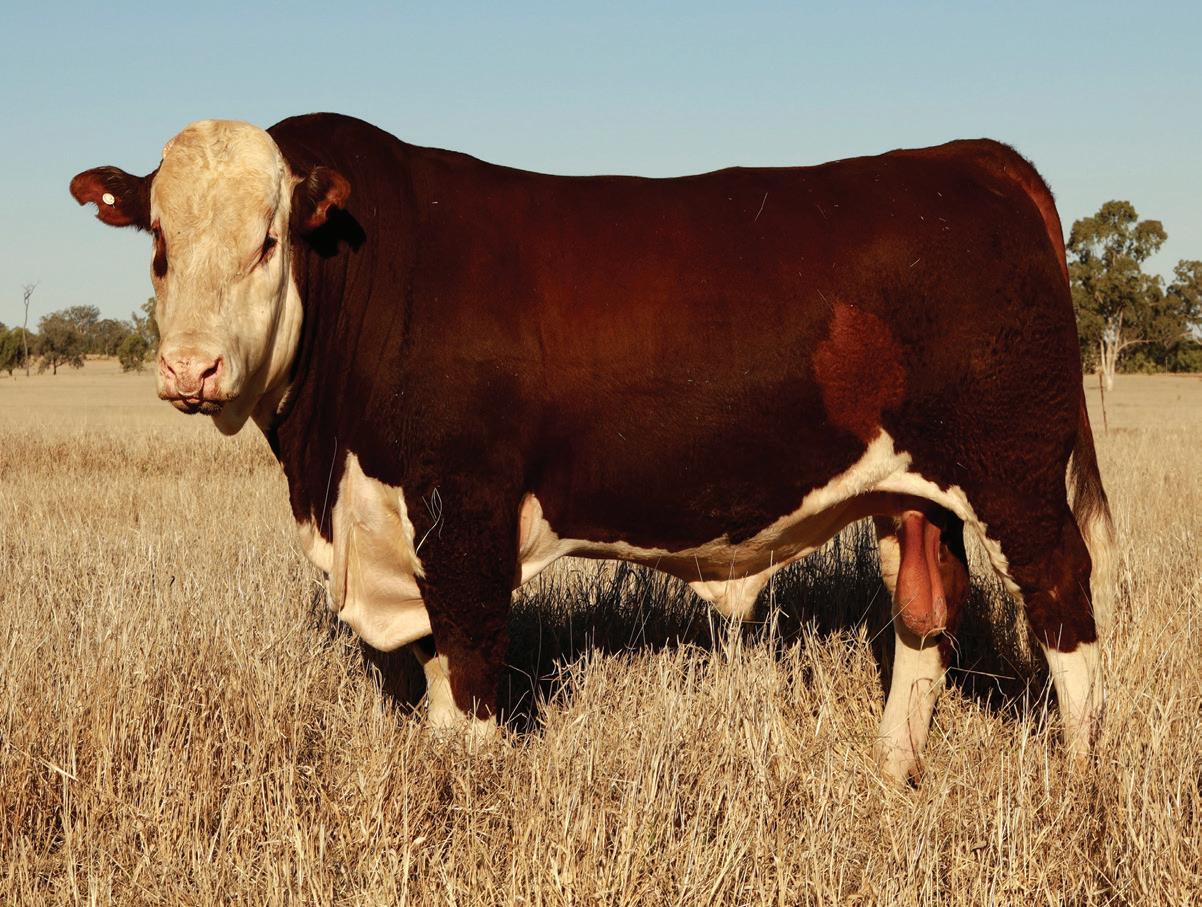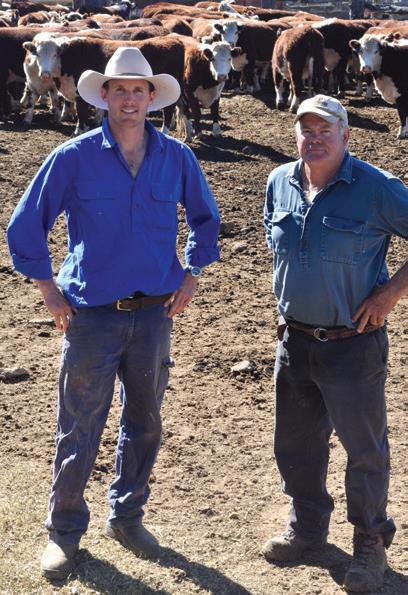
4 minute read
Wandong celebrating a platinum anniversary of commercial Hereford production
By Kim Woods
The Bjorksten family has stayed true to their values across 70 years of commercial Hereford breeding – fertile, efficient females producing steers hitting the end user specifications off grass.
Advertisement
The family operates Wandong Herefords, a 34,000 DSE enterprise on 3.25 labour units, across two properties at Yeoval and Guyra in NSW, and has a sister herd, Beralga, at St George, in Queensland.
Ian and Jennifer Bjorksten operate Wandong Herefords breeding herd and finishing enterprise at “Wandoo”, Yeoval, while their son James and his wife Sarah run a grass finishing operation and breeding herd at “Green Valley”, Guyra.
Ian’s brother Daryl and his wife Antoinette run the Beralga herd at St George.
Wandong Herefords was founded in 1952 by Norman and Ruby Bjorksten, who sourced high quality Hereford cows at annual production sales at Benambra, in the Victorian high country.
An early influential sire, Illiston Ausborne, purchased in 1960 was joined to 40 cows twice a year for several years, and after entering progeny into carcase trials at Shepparton abattoir in the 1960s, it was discovered he was exceptional for IMF (intramuscular fat).
Ian recalls one of their yearling steers achieved a higher marble score than a competitor’s three-year-old bullock. He believes the sire still has an influence on the IMF potential of the Wandong cow herd today.

Originally running 350 cows at “Sungaron”, Seymour, Victoria, the Bjorksten family moved to “Wandoo Wandong”, Yeoval, in 1973.

FROM PAGE 83 numbers were increased to 1000 cows and sheep were gradually phased out by the early 1990s.
In 1982, the family acquired “Glenmuir”, St George, Qld, to help maintain cow numbers during the drought. In 1998 Norman and Daryl Bjorksten purchased “Beralga”, St George, where Daryl and Antoinette still operate.
During the 1990s many of the Wandong steers were finished through Myola feedlot, where they achieved industry leading feed conversion efficiency results in both short term and 150 day feeding programs.
James was awarded the Hereford Society EA Southee Scholarship in 2001, when he attended the annual Beef Congress in Houston Texas. Learning from this study tour was the inspiration for starting “Hereford Red” branded beef some 10 years later.
Ian purchased an additional 1000ha at Cumnock in 2012, with an adjoining 600ha lease block.
A testament to the resilience of the Hereford breed is the Wandong cow herd returned to full numbers by 2022, after three years of crippling drought from 2017-2020.
Ian’s focus today is to grow pastures that can provide feed for high performance of his herd year-round.
Wandong and Beralga total 1900 breeders and is a vertically integrated enterprise across the three geographic regions.
Prior to the drought, Wandong Herefords had developed their own grass-fed beef brand, Hereford Red, with steers processed and graded with a tight MSA boning spec, averaging an MSA Index of 63.28 and marble score 2 over a decade of processing every six to 10 weeks.
The brand was embraced by local chefs from the Central West, Central Coast and Sydney, and at the peak was consuming over 60 per cent of the steer drop, or 350 head a year.

To meet the specs, James used an adaptive grazing management system based on animal health and performance. He monitored cattle on their rumen health signals and managed pasture to maximise quality.
Hereford Red was paused during the drought, with plans to recommence when conducive trading conditions return.
“We are focusing on what we do best – producing high quality grass-fed Hereford beef and most of our product goes into Coles Graze assured grass-fed brand.”
James and Sarah moved to “Green Valley”, Guyra, in 2020 after spending some years off-farm and returned to the agricultural sector with a fresh passion.
In regard to the Wandong herd, there has always been a strong focus on selection for high fertility in the females and carcase traits in the bulls.
“We buy balanced bulls with length, frame, depth and volume, with a strong emphasis on 600-day growth, and the carcase attributes of EMA, IMF and yield.
James likes to exchange ideas with his brother Tom, an innovator in chemicalfree, zero-external input soils using biomass and ground cover to build organic matter.
“I’m focused on the vertical integration of the business – not just moving cattle from place to place but how we can integrate, work together to improve the production systems on all of our properties,” James said.
Under the vertically integrated system, Daryl calves cows down 650 breeders at St George, and sends the weaners to “Green Valley” Guyra for growing out.
The tops of the replacement heifers are sent back to St George for joining, and the steers and surplus heifers are then sent to Yeoval for finishing over winter on cereal crops.
Starting at an average of 300kg liveweight, the 450 weaner steers and heifers sent to “Green Valley” in September 2022 had an average daily gain of 1.3kg over 160 days on grass only.
James and Ian aim to achieve 1kg/day of lifetime gain in the steers at Wandoo Wandong and Green Valley. Pastures are predominantly multi-species winter active, summer dormant species at Yeoval and the opposite at Guyra being highly summer active species including fescue, red and white clover.
The steers are rotationally grazed through 10-40ha sized paddocks in mobs of 100-150 for seven days per paddock to keep the pastures at a vegetative, highly digestible growth stage.
In terms of compliance, Ian is careful in targeting the cattle to finish at Yeoval to the right carcase weight, yield and fat specifications.
Heifers are joined via AI at Yeoval, using semen from curve bending sires leading in calving ease and low birthweight EBVs. Wandong yearling bulls are used as back-ups to the heifers across a six week joining.
“This gives us a tight calving pattern and results in a 65-70 per cent pregnancy rate to the AI, with the back-up bulls picking up the balance,” James said.
“The early born AI calves are identified separately. Heifers are culled if they are empty at pregnancy testing and are fattened and sold.”
With an average herd age of four to five years, females are joined in May and October for an autumn and spring calving.
Weaning protocol at each property involves yard weaning for five to seven days, positive socialisation, low stress stock handling and supplementary feeding.
James aims to champion the modern Hereford for its feed efficiency and high yielding carcase off grass.
“I don’t see any reason why Herefords can’t be an important part of the Australian beef industry in the future,” he said.
“They are unbeatable as grass converters and finishers. For us it makes a lot of sense as we finish on grass. We have backgrounded and finished other breeds as trade cattle but have never consistently had the performance off grass we have had with the Herefords.
“We are a family business and have always stayed consistent with our values – Norman would be pretty proud the three of us are working together as a family.”










